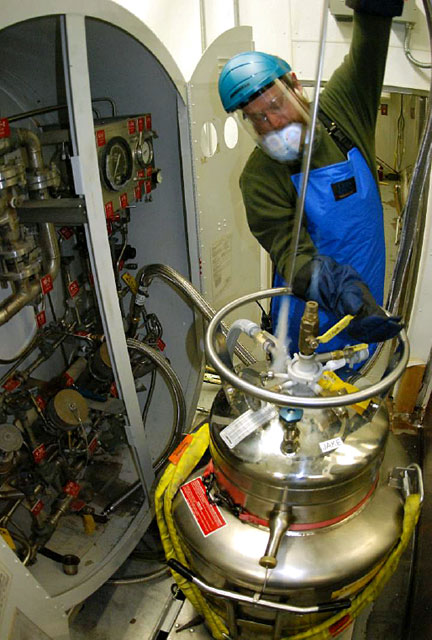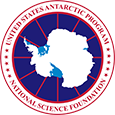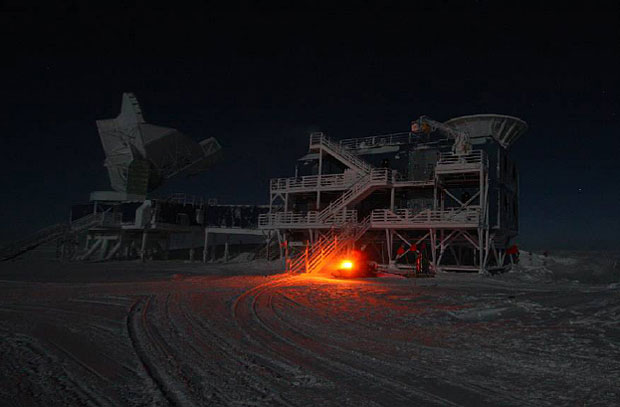|
Deep freezeSouth Pole experiments require extremely cold temperatures to operatePosted August 26, 2011
Of all the places in the world, one would not think of the South Pole as the home of a state-of-the-art cryogenic facility. After all, this is one of the coldest places on the planet. Although too cold to support life, even the South Pole is not cold enough to accommodate the advanced astrophysical research that is done here. Cryogenics, from the Greek cryo for cold, is the science of producing, storing, and delivering very cold temperatures. The basis of cryogenics is the liquefaction of gases. At sea level, water molecules liquefy at a temperature of 100 degrees Celsius. Above that temperature, water exists as a gas, and below that temperature, it exists as a liquid. Warm up water on a stove and, when it reaches a temperature of 100C, it will boil off and turn into a gas. The same thing is true for a variety of other substances. Two of them in particular have boiling points so low that they find applications as cryogenics. One is nitrogen, which boils off at a temperature of minus 196C, and the other is helium, which boils off at a temperature of minus 269C. 
Photo Credit: Angela Jones
South Pole cryogenic technician Nick Strehl tranfers liquid helium from a 10,000-liter transport dewar directly into a 250-liter dewar for delivery to the BICEP telescope.

Photo Credit: Freija Deschamps
The helium that cannot be re-liquefied is stored in gaseous form and used to fill meteorological balloons. NOAA Corps officer Christy Schultz releases a balloon into the polar night to monitor ozone depletion. These balloons expand to a diameter of 10 meters and reach altitudes of 30,000 meters.
These temperatures are so low that they are measured on a different scale, called the Kelvin scale, which references temperature to the absolute zero, the lowest temperature that could ever be attained, where all molecular motion stops. On that scale, nitrogen boils off at a temperature of 77K, while helium boils off at a mere 4.2K of temperature. The telescopes at the South Pole Station Producing liquid nitrogen is not that hard, and we can do it right here at the South Pole by compressing and purifying air. Liquid nitrogen is used in some of the telescopes to pre-cool the detectors and in the medical facility for dermatology. But liquid helium is very hard to produce for two reasons. First, it is a rare gas not found in the air. Second, it requires very cold temperatures to liquefy it. Therefore, we have to carry it to the South Pole from the United States in what amounts to one of the most complex transportation processes in the world. The helium is first taken by ship to a storage facility in New Zealand. From there, it is transferred into two gigantic, 10,000-liter dewars, which are loaded into a U.S. Air Force C-17 for transport to McMurdo Station At South Pole, the helium is transferred from the 10,000-liter dewars and stored on-site in smaller, 4,000-liter dewars from which the helium can be further transferred into even smaller 250-liter dewars. These small dewars are put on a sled and pulled by a snowmobile to the various science buildings where it is needed. The science projects consume some 13,000 liters of liquid helium every year, but we have to procure about 20,000 liters per year to account for losses that occur in the transportation and storage of this highly volatile material. Over the years, we have become very good at minimizing helium loss. We now have compressors that re-liquefy most of the helium that would otherwise be lost to evaporation. With further technological improvements, new cost-effective methods are becoming available to re-circulate and refrigerate helium at the point of use in closed-loop systems. Some of the telescopes already use these methods, and it is possible that in the near future we will be able to operate science without a cryogenic facility, redeploying those resources for more exciting scientific discovery.
|



For USAP Participants |
For The Public |
For Researchers and EducatorsContact UsU.S. National Science FoundationOffice of Polar Programs Geosciences Directorate 2415 Eisenhower Avenue, Suite W7100 Alexandria, VA 22314 Sign up for the NSF Office of Polar Programs newsletter and events. Feedback Form |


